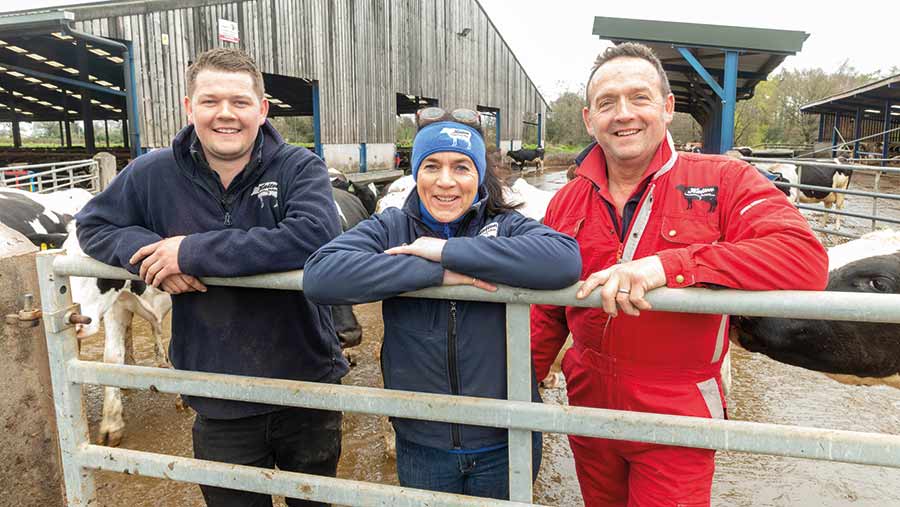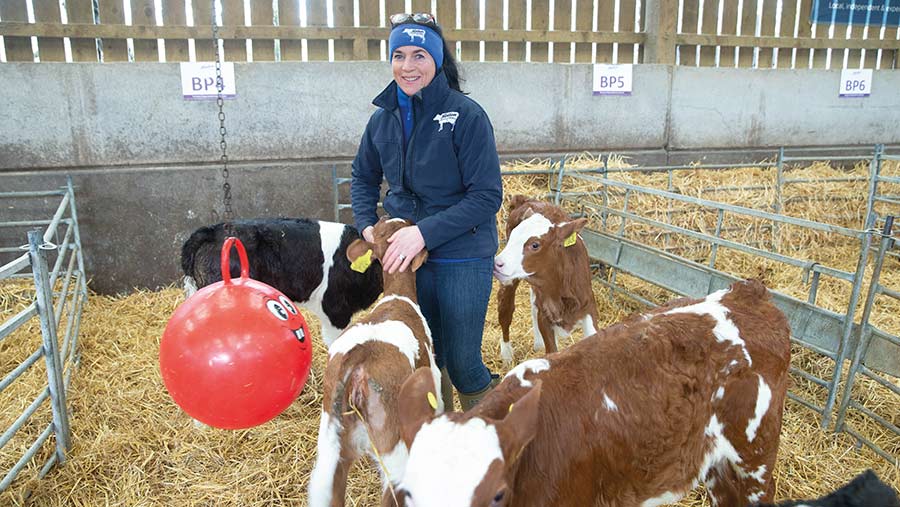Dairy health and welfare underpins transition strategy
 Karen Halton with son Jack (left) and husband Tom © Tim Scrivener
Karen Halton with son Jack (left) and husband Tom © Tim Scrivener A progressive approach to staff management, high welfare standards and selling milk direct are key to the Halton family’s dairy transition strategy.
Cow health and welfare underpin the entire business, says Karen Halton, who farms 240ha with husband Tom and son Jack on their farm at Astbury, near Congleton, Cheshire.
“The cow is queen here and her health is wealth.”
See also: How a slurry chopper pump is enhancing dairy farm efficiency
Farm facts: Halton Farm
- Farm size: 240ha tenanted
- Enterprise: 530 three-way ProCross cows, all-year-round calving, three-times-a-day milking at 4.1% fat, 3.4% protein, 11,000 litres a cow
- Rainfall: 1,000mm
- Soil: clay loams
Transition goals
- Recruit and retain the right staff
- Maintain animal health and welfare
- Increase direct sales to more customers
The 550-cow herd was once Holsteins. But health and fertility issues saw the farm introduce Montbeliarde genetics in 2010.
The result was a 25% increase in yields. “Nowhere else in farming uses a single breed. Whether it is sheep, pigs or potatoes, there is always a cross to promote hybrid vigour,” says Tom.
“Even with two breeds, that initial level of vigour declines over time.”
Switching to a three-way cross maintains the genetic variation and an element of vigour, known as heritosis.
The farm now uses a ProCross dairy cow – a three-way cross of Montbeliarde, Viking Holstein and Viking Red.
At 32%, the Halton herd’s 21-day pregnancy rate is more than double the UK average of between 14-16%.
The farm has a rigorous vaccination policy, with weekly checks carried out by the vet. Any concerns are addressed before they become an issue.
The detailed health and welfare management extends to the 300 youngstock.
Heifer calves are weighed monthly to ensure growth rates are maintained and this allows first calving at 22 months, well below the national average of 28-29 months.

© Tim Scrivener
Staff management
Recruiting and retaining the right staff will be the biggest challenge facing British farming over the coming years, Tom believes.
There is a big emphasis on employee engagement with all 16 staff across the farm and its milk selling business.
The Haltons share performance indicators and costings at regular team meetings, so that everyone takes ownership of what they are trying to achieve.
A staff training programme is also implemented and delivered by outside employment specialists.
Direct sales
The farm prefers to retain control of where its milk is sold. About 25% of output is sold directly to customers with the remainder sold through a broker.
About 5,000 litres a week is sold to the public, either through a vending machine or via one of the farm’s four milk rounds.
Currently, about 700 customers pay 130p for a pasteurised litre. The Haltons hope to extend that customer base and add a fifth milk round.
Milk is treated on-farm using a pasteuriser that processes whole milk at a rate of 1,000 litres/hour, with 500 litres of this skimmed.
Whole and skimmed milk are combined to produce semi-skimmed, which is put into screw-top glass bottles.
The recyclable glass bottles are more environmentally friendly than plastic alternatives and are part of the appeal for customers.
Vending machine customers can dispense milk from a tank into their own container or buy a glass bottle.
This has proved popular and about 120 litres/day are sold through the machine.
Other outlets include 2,000 litres/week to a cheese producer, a further litreage as a range of products and 21,000 litres to a neighbouring farmer with a barista milk contract.
Forage management
A one-day paddock system is used for cows, with heifers following on.
The cattle help fertilise the ground, and further soil nutrients are supplied by a move to multispecies leys on a 16ha area that includes nitrogen-fixing legumes.
The mix includes 21 different species of grass, clover, chicory birdsfoot trefoil and lucerne, and the farm receives £450/ha stewardship payment for using it.
The area of multispecies mixes will be extended to 26ha this year.
Another move that has helped to reduce fuel costs and improve feed quality is the purchase of a forage wagon to facilitate a multicut silage system.
Last year, the farm took five cuts from April to November with protein levels up to 28%.
Hybrid rye is grown on 10ha as a low-input crop, providing quality feed for dry cows.
Cover crops have also been added after the 60ha maize crop to reduce nutrient leaching and run-off.
Karen Halton is one of our Transition Farmers. Join her as Halton Farm strives to become financially and environmentally sustainable and overcome the challenges it faces over the next five years.
